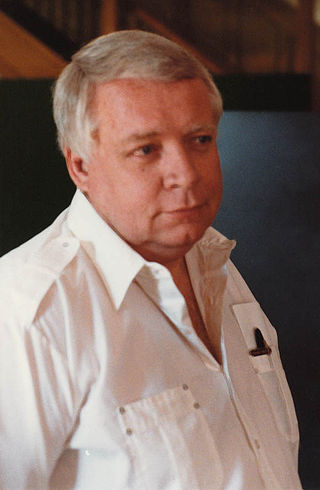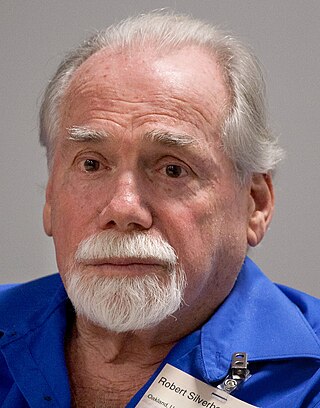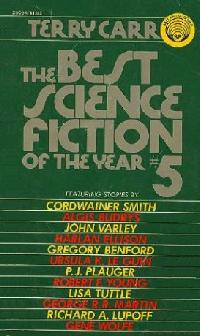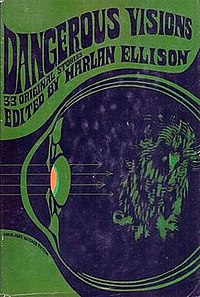
Harlan Jay Ellison was an American writer, known for his prolific and influential work in New Wave speculative fiction and for his outspoken, combative personality. His published works include more than 1,700 short stories, novellas, screenplays, comic book scripts, teleplays, essays, and a wide range of criticism covering literature, film, television, and print media. Some of his best-known works include the 1967 Star Trek episode "The City on the Edge of Forever", considered by some to be the single greatest episode of the Star Trek franchise, his A Boy and His Dog cycle, and his short stories "I Have No Mouth, and I Must Scream" and "'Repent, Harlequin!' Said the Ticktockman". He was also editor and anthologist for Dangerous Visions (1967) and Again, Dangerous Visions (1972). Ellison won numerous awards, including multiple Hugos, Nebulas, and Edgars.
The New Wave was a science fiction style of the 1960s and 1970s, characterized by a great degree of experimentation with the form and content of stories, greater imitation of the styles of non-science fiction literature, and an emphasis on the psychological and social sciences as opposed to the physical sciences. New Wave authors often considered themselves as part of the modernist tradition of fiction, and the New Wave was conceived as a deliberate change from the traditions of the science fiction characteristic of pulp magazines, which many of the writers involved considered irrelevant or unambitious.

Algirdas Jonas "Algis" Budrys was a Lithuanian-American science fiction author, editor, and critic. He was also known under the pen names Frank Mason, Alger Rome in collaboration with Jerome Bixby, John A. Sentry, William Scarff, and Paul Janvier. In 1960, he authored Rogue Moon, a novel.

Robert Silverberg is an American author and editor, best known for writing science fiction. He is a multiple winner of both Hugo and Nebula Awards, a member of the Science Fiction and Fantasy Hall of Fame, and a Grand Master of SF. He has attended every Hugo Award ceremony since the inaugural event in 1953.
The Last Dangerous Visions is an unpublished original speculative fiction anthology intended to follow Dangerous Visions (1967) and Again, Dangerous Visions (1972). Like its predecessors, it was edited by American author Harlan Ellison, with introductions to be provided by him. Ellison died in 2018 with the anthology unfinished.
Arthur Byron Cover is an American science fiction author.
"Gonna Roll the Bones" is a fantasy novelette by American writer Fritz Leiber, in which a character plays craps with Death. First published in Harlan Ellison's Dangerous Visions, it won both the Hugo Award and Nebula Award for Best Novelette.
"The Doll-House" is a short story by Hugh Jones Parry, under the name "James Cross". It was first published in Harlan Ellison's 1967 science fiction anthology Dangerous Visions.
"If All Men Were Brothers, Would You Let One Marry Your Sister?" is a science fiction short story by American writer Theodore Sturgeon. It first appeared in Harlan Ellison's anthology Dangerous Visions in 1967.

The 1974 Annual World's Best SF is an anthology of science fiction short stories edited by Donald A. Wollheim and Arthur W. Saha, the third volume in a series of nineteen. It was first published in paperback by DAW Books in May 1974, followed by a hardcover edition issued in September of the same year by the same publisher as a selection of the Science Fiction Book Club. For the hardcover edition the original cover art of Jack Gaughan was replaced by a new cover painting by Victor Valla. The paperback edition was reissued by DAW in December 1979 under the variant title Wollheim's World's Best SF: Series Three, this time with cover art by Vicente Segrelles. A British hardcover edition was published by The Elmfield Press in October 1975 under the variant title The World's Best SF Short Stories No. 1.

World's Best Science Fiction: 1966 is an anthology of science fiction short stories edited by Donald A. Wollheim and Terry Carr, the second volume in a series of seven. It was first published in paperback by Ace Books in 1966. It was reprinted by the same publisher in 1970 under the alternate title World's Best Science Fiction: Second Series. An Italian edition appeared in December 1966 under the title Il vento del sole.

World's Best Science Fiction: 1970 is an anthology of science fiction short stories edited by Donald A. Wollheim and Terry Carr, the sixth volume in a series of seven. It was first published in paperback by Ace Books in 1970, followed by a hardcover edition issued in September of the same year by the same publisher as a selection of the Science Fiction Book Club and a British hardcover edition issued in November of the same year by Gollancz.

World's Best Science Fiction: 1968 is an anthology of science fiction short stories edited by Donald A. Wollheim and Terry Carr, the fourth volume in a series of seven. It was first published in paperback by Ace Books in 1968. It was reprinted by the same publisher in 1970 under the alternate title World's Best Science Fiction: Fourth Series. The first hardcover edition was published by Gollancz in 1969.

The Best Science Fiction of the Year #5 is an anthology of science fiction short stories edited by Terry Carr, the fifth volume in a series of sixteen. It was first published in paperback by Ballantine Books in July 1976.

The Dark Between the Stars is a 1981 collection of previously-published science fiction short stories by American writer Poul Anderson.

Alpha 2 is a science fiction anthology edited by Robert Silverberg, first published as a paperback original by Ballantine Books in November 1977. No further editions have been issued. .

Nebula Award Stories 3 is an anthology of award-winning science fiction short works edited by Roger Zelazny. It was first published in the United Kingdom in hardcover by Gollancz in November 1968. The first American edition was published by Doubleday in December of the same year. Paperback editions followed from Pocket Books in the U.S. in February 1970, and Panther in the U.K. in November 1970. The American editions bore the variant title Nebula Award Stories Three. The book was more recently reissued by Stealth Press in hardcover in June 2001. It has also been published in German.

Nebula Award Stories Two is an anthology of science fiction short stories edited by Brian W. Aldiss and Harry Harrison. It was first published in hardcover by Doubleday in September 1967, with a Science Fiction Book Club edition following in November 1969. The first British edition was published by Gollancz in 1967, under the variant title Nebula Award Stories 1967. Paperback editions followed from Pocket Books in the U.S. in September 1968, and Panther in the U.K. in 1970. The Panther edition bore the variant title Nebula Award Stories 2. The book was more recently reissued by Stealth Press in hardcover in September 2001. It has also been published in German.

Nebula Award Stories Seventeen is an anthology of award winning science fiction short works edited by Joe Haldeman. It was first published in hardcover by Holt, Rinehart and Winston in August 1983; a paperback edition was issued by Ace Books in June 1985 under the variant title Nebula Award Stories 17.

Nebula Award Stories Sixteen is an anthology of award winning science fiction short works edited by Jerry Pournelle and John F. Carr. It was first published in hardcover by Holt, Rinehart and Winston in August 1982; a paperback edition was issued by Bantam Books in September 1983. British editions were issued by W. H. Allen (hardcover) and Star (paperback) in 1983; the latter under the variant title Nebula Winners Sixteen.














